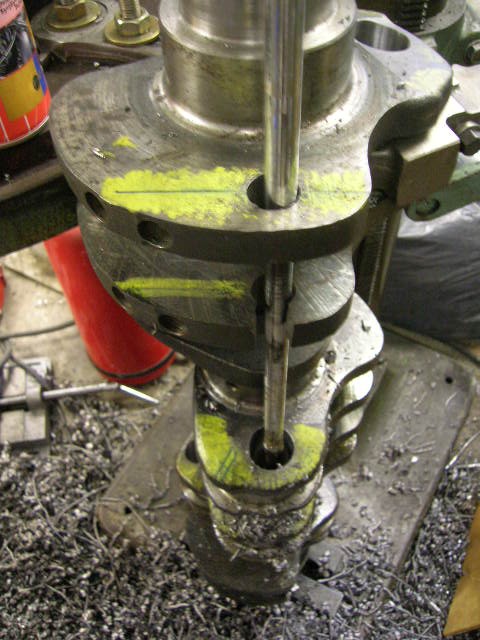February 2010
I cut off much as possible from the counter weights, it lightened about 6kg/13.3lbs more. The drilling already took off around 5.5kg/12lbs. That makes total 11.5kg/25.4lbs off the weight, naturally it going to lose more because counterweights need allot of milling to make them nice and smooth.
Last hole for the crank is now drilled. Next thing to do is to polish all the drilled holes to get rid of scratches left by the drill bit. Those nicks could be a start points for cracks if not grinded off. On the pics you could see how I use the laser to find out oil riffle on the journal and marked it up. Also you could use it to mark the points where to drill through counter weights to reach the journal. Last pic is the crank, ďfresh from the drill
Second last done. I needed to cut open the hole on a lower counter weight to be able to swing the drill bit on its place.
To reach first of the centermost journal, I needed to drill through counterweights of #1 journal. This is where lasers become really handy.
April 08
One more pilot hole has been drilled, with really long 12mm drill bit. Two middle ones are drawn and are next on the list.
First hole done to the rear of the crank, the drill bit needed some grinding due to flange.
Second hole done, weighted the crank and itís now 500g (1.1 lbs) lighter, so one hole reduces 250g that times six makes 1.5kg (3.3lbs) but itís going to be more lighter when all the work has done. Turned it upside down and did the drawings for the two rearmost journals. These two require some mods for the drill bit due to flange on the way.
Grind a drill bit to have a guide (12mm) to keep it center in the hole while drilling and finished first one up to 31mm.
Put the crank on a scale to get the weight before any has work done for it. The scale showed 55.8 kg/122.8 lbs. Also drilled the pilot hole, going to drill them step by step up to around 34mm/1.34"
Feb. 08
Started to build a new engine, itís going to have 24v head and some other things, but lets start with the crank shaft. I first did a simple scraper tool to mark a bearing surface, then by using a welding rod, to see where oil passage is located and marked it up, the socket is there to estimate the position of a hole to be drilled. Modified an old rod to use it as a upper support for the crank when it stands under the pole drill:

